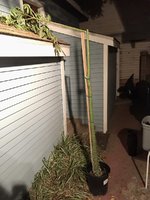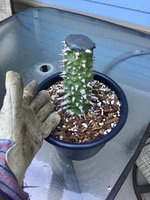It should. But I would go with hard chops in the active growing season. If you leave one long branch the others might not bud back.
Okay thx... what is a hard chop? So if I leave one long branch, you do mean that it will not grow back other top branches, correct? So then at some point in the future, when lower growth has established, I might cut back that one top branch which was left?
They appear to be apically dominant, favoring tall top growth over short side branches.
Do you mean the species, or these particular specimens, due to the lower branches having been cut early?
For me, large cuttings (3-8”) have rooted easily in coarse sand or pumice during the growing season. I don’t recall if I used rooting hormone.
You use fine pumice, correct? How would coir, sphagnum moss, vermiculite, and or perlite work? I have these all, as well as a cloning machine, if that'd do it for such a thick cutting... Or should I get the fine pumice or coarse sand?
In coastal SoCal, I had a large patio tree for a decade. Then later bought an 8’ straight trunk nursery tree (8” dia). Chopped it into many segments and the majority rooted and then sent out buds. The one pictured was the base of the tree, mostly flat cut at the roots and trunk chopped at the same time.
Forgive me, please explain 'mostly' flat cut at the roots and trunk chopped 'at the same time'... I am still somewhat novice!
It sent 3-4 shoots and after a few years of thickening/wound healing, I chopped it again. This time each shoot only produced one shoot and the largest branch also activated a lower bud.
Again, please elucidate, how the largest branch here triggers a lower bud... is the lower bud the little shoot coming out the side of the pot... or which looks a bit like a pretty weed?? lol
The shoots appear to bud just above the former attachments sites for the first year leaf stipules (which can be hard to see on old wood). A bottom pic has an old one circled that didn’t push and the last pic shows the attachments from last years leaves. Ignore the squirrel planted oak. This one overwintered in the garage in Zone 6 with light. It was out of leaf until a couple weeks ago.
View attachment 484223View attachment 484224View attachment 484225View attachment 484226View attachment 484227
These guys look really beautiful!!
So then, it can be advisable to make big chops like this? Is this a matter of personal preference, as far as whether you mind this kind of big severing? Or can they be somehow healed and grown over as well? In any case, seems like a method I'd like to try. Oh btw... are these bases 8" diameter, or circumference? Unless my sense of scale is off, I would guess circumference? Oh, and how on Earth do you cut such a thick trunk, and do you make the cuts at an angle? Once again, thank you so very much for all the guidance, and sorry for a million follow up questions! It's just that this post has been a great revealer!










